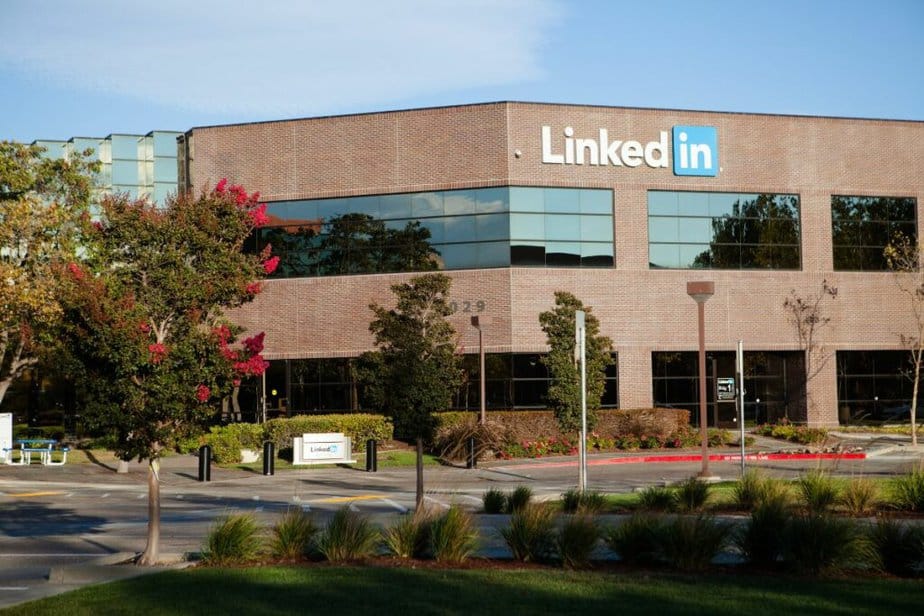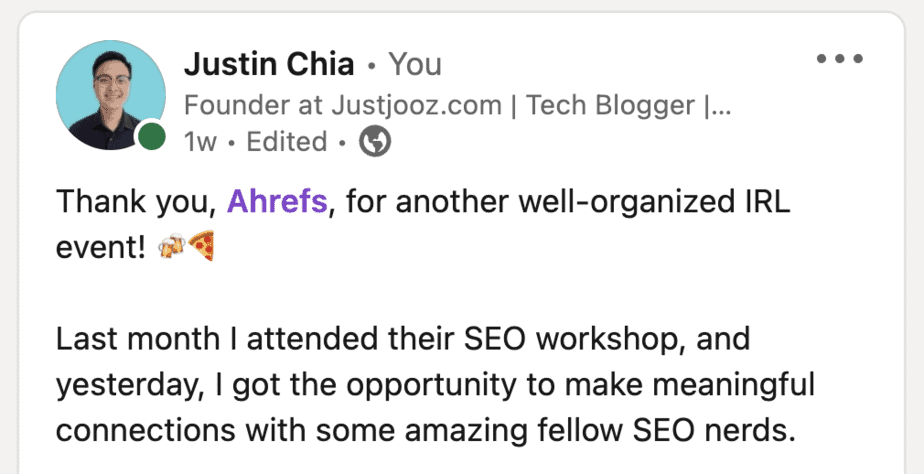50+ Engaging LinkedIn Post Ideas to Stay Ahead in Your Field
We’re reader-supported; we may earn a commission from links in this article.
In today’s fast-paced digital world, LinkedIn has become an essential platform for professionals to showcase their expertise, connect with industry peers, find interesting others, and stay updated on the latest trends.
However, with millions of users vying for attention, creating engaging LinkedIn posts that stand out from the crowd can be challenging.
With this comprehensive collection of 50+ engaging LinkedIn post ideas, you’ll have the tools to stay ahead in your field.
Whether you prefer text posts or have a great idea for visual content, this resource will have an idea that will work for you!
Read on for more ideas!
1. Introduction

LinkedIn has evolved beyond a mere professional networking site; it has become a hub of knowledge sharing and thought leadership.
To make the most of this platform, creating engaging posts that resonate with your target audience is crucial. Let’s dive into some effective strategies and post ideas that will help you make a lasting impact on LinkedIn.
2. Engaging LinkedIn Post Ideas

Now that we’ve discussed strategies and tips for creating engaging LinkedIn posts let’s explore over 50 other article ideas to inspire your content creation:
- Share industry insights and statistics that highlight emerging trends.
- Highlight your recent achievements and milestones, such as certifications or awards.
- Conduct Q&A sessions where you answer common questions from your audience.
- Recommend useful resources, such as books, podcasts, or online courses.
- Share book or podcast recommendations related to your industry.
- Discuss emerging industry trends and provide your perspective on their impact.
- Celebrate the successes and accomplishments of your team members.
- Provide career development tips and strategies for professional growth.
- Conduct polls and surveys to gather opinions or insights from your network.
- Ask for feedback on a new product or service you’re launching.
- Share inspiring stories of individuals who have overcome challenges in your industry.
- Offer quick tips and hacks that can help professionals excel in their roles.
- Showcase your company culture and values by highlighting employee experiences.
- Discuss the importance of work-life balance and share strategies to achieve it.
- Highlight your involvement in community initiatives or charitable causes.
- Offer expert advice on a specific aspect of your industry.
- Share behind-the-scenes insights from a recent project or event.
- Interview industry leaders or influencers and share their insights with your network.
- Provide step-by-step tutorials or guides on industry-related tasks or skills.
- Discuss the impact of emerging technologies on your field.
- Share success stories of clients or customers who have benefited from your services.
- Offer tips for effective networking and building professional relationships.
- Discuss the challenges and opportunities of remote work or freelancing.
- Analyze industry trends and provide predictions for the future.
- Share productivity hacks and time management strategies.
- Provide tips for effective public speaking or presentation skills.
- Discuss the benefits of mentorship and share your experiences with mentors.
- Explain complex industry concepts or processes in a simplified manner.
- Highlight the importance of diversity and inclusion in the workplace.
- Share your favorite productivity tools or software that can benefit professionals.
- Discuss the impact of artificial intelligence or automation on your field.
- Provide tips for effective project management and organization.
- Share personal anecdotes or stories that offer valuable lessons.
- Discuss the role of emotional intelligence in professional success.
- Offer advice for job seekers, such as resume tips or interview strategies.
- Discuss the value of continuous learning and recommend online courses or resources.
- Share tips for effective teamwork and collaboration.
- Discuss the importance of personal branding and share strategies for building a strong online presence.
- Highlight the benefits of attending industry conferences or events.
- Discuss the future of your industry and how professionals can prepare for it.
- Share inspiring quotes or motivational messages that resonate with your audience.
- Offer tips for maintaining a healthy work-life integration.
- Discuss strategies for managing stress and achieving work-life balance.
- Provide insights on how to effectively leverage social media for professional growth.
- Share your favorite industry-related blogs or websites.
- Discuss the impact of changing consumer behavior on your industry.
- Offer advice for entrepreneurs or startups looking to succeed in your field.
- Highlight the importance of continuous professional development.
- Discuss the benefits of mentorship programs within organizations.
- Share lessons learned from your own professional journey.
3. The Importance of Engaging LinkedIn Posts
Engaging in LinkedIn posts can benefit professionals in several ways. Firstly, they help you establish yourself as an industry expert, building credibility and trust among your connections.
Secondly, these posts enable you to nurture valuable relationships and expand your network.
Additionally, create posts to engage a higher chance of going viral, reaching a wider audience, and attracting potential clients, partners, or new job opportunities in the LinkedIn platform.
4. How to Generate Engaging LinkedIn Post Ideas
To make eye-catching and highly engaging LinkedIn post ideas, I think it’s best that we follow a few best practices. Here they are:
a. Understanding Your Target Audience
To create LinkedIn posts and branded content that resonate with your audience, it’s essential to understand their needs, challenges, and aspirations.
Conduct thorough research on your target audience’s demographics, professional backgrounds, and interests.
This knowledge will empower you to tailor your content to their preferences and deliver value that addresses their pain points.
b. Leveraging Current Industry Trends
Staying up to date with the latest industry trends is crucial for professionals looking to position themselves as thought leaders.
Monitor industry publications, attend webinars and conferences, write, and engage in conversations within your niche.
By leveraging these trends, you can provide timely insights and engage your audience with relevant and valuable content.
Recently, there’s been lots of chatter about AI trends, including using AI to zoom out of an image and extending the view of an overly-zoomed-in image with AI.
Such posts can help demonstrate your interest or flair in data science/AI, and are good for building a data analyst LinkedIn portfolio
c. Sharing Personal Experiences and Stories
People connect with stories, and a great example of sharing your personal experiences can humanize your LinkedIn posts and make you relatable to your audience.
Consider sharing stories of challenges you’ve overcome, lessons you’ve learned, or milestones you’ve achieved in your career.
By sharing your own story and journey, you inspire and motivate others while building a genuine connection with your network.
d. Asking Thought-Provoking Questions
Engaging your audience in meaningful conversations is a powerful way to foster interaction and gather insights.
Pose thought-provoking questions related to your industry or a trending topic. Encourage your connections to share their perspectives, experiences, and opinions.
This generates engagement and provides you with valuable feedback and different viewpoints.
e. Providing Valuable Tips and Advice
One of the best ways to add value to your LinkedIn network is by sharing actionable data analytics tips and advice.
Identify common pain points or challenges within your industry and offer practical solutions. By positioning yourself as a resourceful professional, you establish yourself as a go-to person for expertise and guidance.
5. Creative Content Formats for LinkedIn Posts
To keep your LinkedIn posts engaging and captivating, consider experimenting with various content formats. Here are some creative content ideas to explore:
a. Infographics and Visual Content
Visual content is highly effective in grabbing attention and conveying information concisely.
Create eye-catching infographics, charts, or images that present data, statistics, or key takeaways in a visually appealing manner. Visual content is easily shareable and can boost engagement on your posts.
b. Inspirational Quotes and Motivational Messages
Everyone loves a bit of inspiration. Share uplifting quotes or motivational messages that resonate with your audience.
These posts can provide encouragement, drive, and positivity, earning you appreciation and engagement from your connections.
c. Case Studies and Success Stories
Highlight real-life examples of successful projects, research reports, client success stories, or personal achievements.
Case studies showcase your expertise and inspire others by demonstrating the tangible results you’ve delivered. Be sure to include specific details and metrics to make your blog posts more compelling.
d. Behind-the-Scenes Sneak Peeks
Take your audience behind the scenes of your work or company.
Show them glimpses of your creative process, project development, or day-to-day business operations. This allows your connections to get a closer look at your work culture and builds transparency and authenticity.
e. Industry News and Updates
Keep your network informed about the latest news, trends, and developments in your industry.
Share interesting articles, reports, or studies that provide valuable insights. Offering relevant and timely information positions you as a reliable source of industry updates.
6. Tips for Writing Engaging LinkedIn Posts
Crafting captivating LinkedIn posts requires careful consideration of various factors. Here are some tips to make your posts stand out:
Here’s an example on a LinkedIn Post that I created recently at an event I attended. You can take reference to how I grabbed attention using emojis and punchlines.

a. Use Attention-Grabbing Headlines
Your headline is the first thing people see, so make it compelling and attention-grabbing.
Pose a question, make a bold statement, or use powerful words that evoke curiosity, the same questions, or emotions. A catchy headline entices users to click and read your full blog post.
b. Keep Your Posts Concise and Easy to Read
LinkedIn is a professional platform where users prefer concise and to-the-point content. Keep your posts brief, using short paragraphs and bullet points to enhance readability.
Use simple and jargon-free language to ensure your message is easily understandable.
c. Incorporate Visual Elements
Visual elements such as images, videos, or infographics enhance the visual appeal of your posts and make them more shareable. Including relevant visuals in long-form content can also help illustrate your points or add context and more detail to your content.
Create a LinkedIn video for higher engagements as people will trust your brand and face.
d. Encourage Interaction and Discussion
End your posts with a clear call-to-action that encourages users to engage in conversation with other posts.
Pose a question, ask for opinions, or invite your connections to share their experiences in the comments.
Engage with the comments and foster meaningful conversations to build a sense of community.
LinkedIn’s platform provides an excellent opportunity to connect with professionals across various fields, so make sure your linkedin profile is well-optimized and showcases your expertise.
Actively participate in relevant groups, join conversations, and respond to comments, nurturing a sense of community.
e. Utilize Relevant Hashtags
Hashtags help categorize your posts and make them discoverable to a wider audience.
Research and use relevant hashtags that are popular within your industry or related topics.
Hashtags increase the visibility of your posts and allow users who follow those hashtags to find your user-generated content more easily.
7. Engaging LinkedIn Post Ideas
Now that we’ve discussed strategies and tips for creating engaging LinkedIn posts let’s explore over 50 other article ideas to inspire your content creation:
- Share industry insights and statistics that highlight emerging trends.
- Highlight your recent achievements and milestones, such as certifications or awards.
- Conduct Q&A sessions where you answer common questions from your audience.
- Recommend useful resources, such as books, podcasts, or online courses.
- Share book or podcast recommendations related to your industry.
- Discuss emerging industry trends and provide your perspective on their impact.
- Celebrate the successes and accomplishments of your team members.
- Provide career development tips and strategies for professional growth.
- Conduct polls and surveys to gather opinions or insights from your network.
- Ask for feedback on a new product or service you’re launching.
- Share inspiring stories of individuals who have overcome challenges in your industry.
- Offer quick tips and hacks that can help professionals excel in their roles.
- Showcase your company culture and values by highlighting employee experiences.
- Discuss the importance of work-life balance and share strategies to achieve it.
- Highlight your involvement in community initiatives or charitable causes.
- Offer expert advice on a specific aspect of your industry.
- Share behind-the-scenes insights from a recent project or event.
- Interview industry leaders or influencers and share their insights with your network.
- Provide step-by-step tutorials or guides on industry-related tasks or skills.
- Discuss the impact of emerging technologies on your field.
- Share success stories of clients or customers who have benefited from your services.
- Offer tips for effective networking and building professional relationships.
- Discuss the challenges and opportunities of remote work or freelancing.
- Analyze industry trends and provide predictions for the future.
- Share productivity hacks and time management strategies.
- Provide tips for effective public speaking or presentation skills.
- Discuss the benefits of mentorship and share your experiences with mentors.
- Explain complex industry concepts or processes in a simplified manner.
- Highlight the importance of diversity and inclusion in the workplace.
- Share your favorite productivity tools or software that can benefit professionals.
- Discuss the impact of artificial intelligence or automation on your field.
- Provide tips for effective project management and organization.
- Share personal anecdotes or stories that offer valuable lessons.
- Discuss the role of emotional intelligence in professional success.
- Offer advice for job seekers, such as resume tips or interview strategies.
- Discuss the value of continuous learning and recommend online courses or resources.
- Share tips for effective teamwork and collaboration.
- Discuss the importance of personal branding and share strategies for building a strong online presence.
- Highlight the benefits of attending industry conferences or events.
- Discuss the future of your industry and how professionals can prepare for it.
- Share inspiring quotes or motivational messages that resonate with your audience.
- Offer tips for maintaining a healthy work-life integration.
- Discuss strategies for managing stress and achieving work-life balance.
- Provide insights on how to effectively leverage social media for professional growth.
- Share your favorite industry-related blogs or websites.
- Discuss the impact of changing consumer behavior on your industry.
- Offer advice for entrepreneurs or startups looking to succeed in your field.
- Highlight the importance of continuous professional development.
- Discuss the benefits of mentorship programs within organizations.
- Share lessons learned from your own professional journey.
Remember, these ideas are just an idea, a starting point.
Conclusion
Creating engaging LinkedIn posts is an effective way to establish yourself as an industry expert, expand your network, and stay ahead in your field.
You can craft compelling content that captivates your audience by understanding your target audience, leveraging current industry trends, sharing personal experiences, asking thought-provoking questions, and providing valuable tips and advice.
Additionally, utilizing creative video content formats, following writing tips, and incorporating a variety of engaging LinkedIn post ideas will help you maintain an active presence and foster meaningful interactions on the platform.
FAQs – LinkedIn Post Ideas
How often should I post on LinkedIn?
Posting frequency on LinkedIn can vary depending on your goals and available time. However, it’s recommended to aim for at least a few posts per week to maintain an active presence and engage your audience.
Can I share personal stories on LinkedIn?
Yes! Sharing personal stories on LinkedIn humanizes your brand and allows your audience to connect with you on a deeper level. It helps build authenticity and fosters genuine relationships with your connections.
Should I use hashtags in my LinkedIn posts?
Yes, using relevant hashtags in your LinkedIn posts can increase your content’s discoverability. Research popular hashtags within your industry or specific topics, incorporate them and publish content strategically to reach a wider audience.
How can I encourage engagement on my LinkedIn posts?
To start conversations and encourage engagement, end your posts with a clear call to action, such as asking a question or inviting your connections to share their thoughts in the comments. Respond to comments promptly and engage in meaningful conversations to foster interaction.
How can I measure the success of my LinkedIn posts?
LinkedIn provides analytics to track the performance of your posts. Monitor metrics such as views, likes, comments, and shares to gauge engagement. Additionally, pay attention to the type of content that resonates most with your audience and adjust your strategy accordingly.

Justin Chia
Justin is the author of Justjooz and is a data analyst and AI expert. He is also a Nanyang Technological University (NTU) alumni, majoring in Biological Sciences.
He regularly posts AI and analytics content on LinkedIn, and writes a weekly newsletter, The Juicer, on AI, analytics, tech, and personal development.
To unwind, Justin enjoys gaming and reading.






